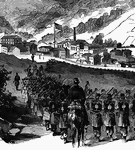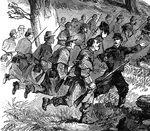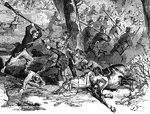Clipart tagged: ‘federal’

Advance of the Federal Army towards Yorktown
When General McClellan reached Locst Hill, on april 2nd, 1862, he found fifty-eight thousand men and…

Howard's Bridge and Mill
"Advance of the Federal troops, near Howard's Bridge and Mill, four miles from Big Bethel, on the road…

Federal Kitchen
"The Federal Kitchen on the march to Fredericksburg with three days' rations." — Frank Leslie,…

View of Grafton
"View of Grafton, West Virginia, occupied by the Federal Troops, under the command of General McClellan,…

Grafton Occupied by Federal Troops
"View of Grafton, West Virginia, occupied by the Federal Troops, under the command of General McClellan,…

Railroad at Grafton
"View of Grafton, West Virginia, occupied by the Federal Troops, under the command of General McClellan,…

Federal Troops at Grafton, West Virginia
"View of Grafton, West Virginia, occupied by the Federal Troops, under the command of General McClellan,…

Battle of Mill Spring
"Battle of Mill Spring, on the Cumberland River, near Jamestown, between a confederate force, 8,000…

Battle of Mill Spring
"Battle of Mill Spring, on the Cumberland River, near Jamestown, between a confederate force, 8,000…

Battle of Mill Spring
"Battle of Mill Spring, on the Cumberland River, near Jamestown, between a confederate force, 8,000…

Battle of Mill Spring
"Battle of Mill Spring, on the Cumberland River, near Jamestown, between a confederate force, 8,000…

Thirteen-inch Shell Mortar Practice
"Mortar practice- 13-inch shell mortar, as used by the Federal government- weight of mortar 17,000 pounds."…

Mortar Practice - Rear View
"Mortar practice- rear view of 13-inch mortar, with its usual complement of seven gunners. The mortar…